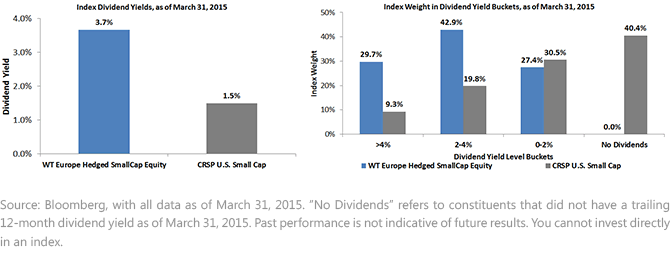Get an Edge: Look at European Small Caps


 For definitions of indexes and terms in the chart, please visit our glossary.
• More than 2x the Dividend Yield: The WisdomTree Europe Hedged SmallCap Equity Index has a dividend yield that was more than twice that of U.S. small caps. As mentioned earlier, this can signal an important potential edge in terms of total return.
• Almost 75% Weight in Stocks with Dividend Yields above 2%: It’s interesting to see how this dividend yield is achieved—clearly weighting by dividends tilts weight toward stocks with higher yields.
1Source: Bloomberg.
For definitions of indexes and terms in the chart, please visit our glossary.
• More than 2x the Dividend Yield: The WisdomTree Europe Hedged SmallCap Equity Index has a dividend yield that was more than twice that of U.S. small caps. As mentioned earlier, this can signal an important potential edge in terms of total return.
• Almost 75% Weight in Stocks with Dividend Yields above 2%: It’s interesting to see how this dividend yield is achieved—clearly weighting by dividends tilts weight toward stocks with higher yields.
1Source: Bloomberg.Important Risks Related to this Article
Dividends are not guaranteed, and a company’s future ability to pay dividends may be limited. A company currently paying dividends may cease paying dividends at any time. Investments focused in Europe are increasing the impact of events and developments associated with the region, which can adversely affect performance. Investments focusing on certain sectors and/or smaller companies increase their vulnerability to any single economic or regulatory development.

Christopher Gannatti began at WisdomTree as a Research Analyst in December 2010, working directly with Jeremy Schwartz, CFA®, Director of Research. In January of 2014, he was promoted to Associate Director of Research where he was responsible to lead different groups of analysts and strategists within the broader Research team at WisdomTree. In February of 2018, Christopher was promoted to Head of Research, Europe, where he was based out of WisdomTree’s London office and was responsible for the full WisdomTree research effort within the European market, as well as supporting the UCITs platform globally. In November 2021, Christopher was promoted to Global Head of Research, now responsible for numerous communications on investment strategy globally, particularly in the thematic equity space. Christopher came to WisdomTree from Lord Abbett, where he worked for four and a half years as a Regional Consultant. He received his MBA in Quantitative Finance, Accounting, and Economics from NYU’s Stern School of Business in 2010, and he received his bachelor’s degree from Colgate University in Economics in 2006. Christopher is a holder of the Chartered Financial Analyst Designation.

